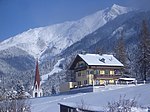Toni-Seelos-Olympiaschanze
1930 establishments in AustriaAustrian sports venue stubsInnsbruck-Land DistrictOlympic Nordic combined venuesOlympic biathlon venues ... and 10 more
Olympic ski jumping venuesSki jumping stubsSki jumping venues in AustriaSports venue stubsSports venues completed in 1930Sports venues in Tyrol (state)Venues of the 1964 Winter OlympicsVenues of the 1972 Winter OlympicsVenues of the 2012 Winter Youth OlympicsWinter Olympic venue stubs

Toni-Seelos-Olympiaschanze is a ski jumping hill in Seefeld outside of Innsbruck, Austria. It is a part of the Seefeld Nordic Competence Centre consisting of two hills, a normal hill with a hill size of HS109 (K-99) and medium hill with at HS75 (K-68). Next to the jumps is a cross-country skiing stadium. It opened in 1931 as Jahnschanze, but was renamed in honor of Anton Seelos in 1948.The venue was used for the normal hill competitions during the 1964 and 1976 Winter Olympics, and for the FIS Nordic World Ski Championships in 1985 and 2019. It is also regularly used for FIS Nordic Combined World Cup.
Excerpt from the Wikipedia article Toni-Seelos-Olympiaschanze (License: CC BY-SA 3.0, Authors, Images).Toni-Seelos-Olympiaschanze
WM Stadion Zufahrt,
Geographical coordinates (GPS) Address External links Nearby Places Show on map
Geographical coordinates (GPS)
| Latitude | Longitude |
|---|---|
| N 47.320833333333 ° | E 11.1775 ° |
Address
Toni Seelos Sprungschanzen (Sprungschanzen Casino Arena;Casino Stadion Seefeld)
WM Stadion Zufahrt
6100
Tyrol, Austria
Open on Google Maps










